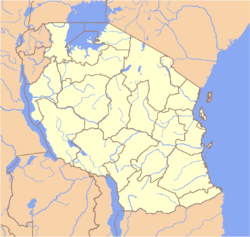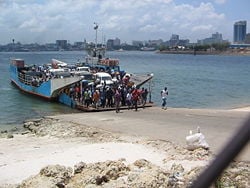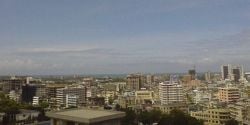Dar es Salaam
| Dar es Salaam | |
| Location of Dar es Salaam | |
| Coordinates: 6°48′S 39°17′E | |
|---|---|
| Country | |
| Districts | List
|
| Government | |
| - Mayor | Adam Kimbisa |
| Area Region/Province | |
| - City | 1,590.5 km² (614.1 sq mi) |
| - Water | 0 km² (0 sq mi) |
| Population (2002) | |
| - Metro | 2,497,940 |
Dar es Salaam (Arabic: دار السلام [translation: "Abode of Peace"] Dār as-Salām), formerly Mzizima, is the largest and richest city in Tanzania, as well as a regionally important economic centre. Though Dar es Salaam lost its official status as capital city to Dodoma in 1996, it remains the centre of the permanent central government bureaucracy and continues to serve as the capital for the surrounding Dar es Salaam Region. The city also hosted a leg of the 2008 Olympic Torch Relay.[1]
Geography
Etymology of name – if available. Topography: Physical qualities of a particular place. Example: Mexico City a. Mountain flanked basin b. on dry lake bed c. vulnerability to earthquakes d. trapped air pollution (also true in L.A. and Athens) Elevation
Situated close to the equator and the warm Indian ocean, the city of Dar es Salaam experiences a tropical climate, typified by hot and humid weather throughout much of the year. The average maximum daytime temperature in January is 90°F (32°C), dropping to an average maximum of around 84°F (29°C) in July. There are two distinct rainy seasons, "the long rains" which fall during April and May, and "the short rains" - during October and November. Annual rainfall is approximately 43 inches (1100mm).
Rivers and canals Size – land area, size comparison Environmental issues
History
In 1859, Albert Roscher of Hamburg became the first European to land in Mzizima ("healthy town"). In 1866 Sultan Seyyid Majid of Zanzibar gave it its present name, an Arabic phrase meaning Abode of Peace. A popular but erroneous translation is "haven of peace" resulting from a mixup of the Arabic words "dar" (house) and "bandar" (harbour). Dar es Salaam fell into decline after Majid's death in 1870, but was revived in 1887, when the German East Africa Company established a station there. The town's growth was facilitated by its role as the administrative and commercial centre of German East Africa and industrial expansion resulting from the construction of the Central Railway Line in the early 1900s.
German East Africa was captured by the British during World War I and from then on was referred to as Tanganyika. Dar es Salaam was retained as the territory's administrative and commercial centre. Under British indirect rule, separate European (e.g. Oyster Bay) and African (e.g. Kariakoo and Ilala) areas developed at a distance from the city centre. The town's population also included a large number of South Asians.
After World War II, Dar es Salaam experienced a period of rapid growth. Political developments, including the formation and growth of the Tanganyika African National Union (TANU), led to Tanganyika attaining independence from colonial rule in December 1961. Dar es Salaam continued to serve as its capital, also when in 1964 Tanganyika and Zanzibar merged to form Tanzania. However, in 1973 provisions were made to relocate the capital to Dodoma, a more centrally located city in Tanzania's interior. The relocation process has not yet been completed, and Dar es Salaam remains Tanzania's primary city.
One of the deadly 1998 U.S. embassy bombings occurred in Dar es Salaam; the other was in Nairobi, Kenya.
Dar es Salaam is located at 6°48' South, 39°17' East (−6.8000, 39.2833).[2] The city is situated on a massive natural harbour on the Eastern Indian Ocean coast of Africa.
Government
The president is both chief of state and head of government. The president and vice president are elected on the same ballot by popular vote for five-year terms and are eligible for a second term. The unicameral National Assembly or Bunge comprises 274 seats, to which 232 members elected by popular vote, 37 allocated to women nominated by the president, five to members of the Zanzibar House of Representatives, all to serve to serve five-year terms.
Dar es Salaam is actually an administrative province within Tanzania, and consists of three local government areas or administrative districts: Kinondoni to the north, Ilala in the center of the region, and Temeke to the south.
Administratively, Dar es Salaam is broken into 3 districts: Ilala, Kinondoni, and Temeke.
Economy
Tanzania is one of the poorest countries in the world. The economy depends on agriculture, which accounts for more than 40 percent of gross domestic product (GDP), provides 85 percent of exports, and employs 80 percent of the work force. Topography and climatic conditions, however, limit cultivated crops to only four percent of the land area. Industry traditionally featured the processing of agricultural products and light consumer goods. The World Bank, the International Monetary Fund, and bilateral donors have provided funds to rehabilitate Tanzania's out-of-date economic infrastructure and to alleviate poverty.
Per capita GDP, rank Financial and business services sector Tourism Manufacturing Transport: Road, rail, air, sea
The Julius Nyerere International Airport connects the city with other African countries, the Middle East, India, as well as Europe.
Dar es Salaam is Tanzania's most important city for both business and government. The city contains unusually high concentrations of trade and other services and manufacturing compared to other parts of Tanzania, which has about 80 percent of its population in rural areas. For example, about one half of Tanzania's manufacturing employment is located in the city despite the fact that Dar holds only ten percent of Tanzania's population.
Located on a natural harbour on the Indian Ocean, it is the hub of the Tanzanian transportation system as all of the country's main railways and several highways originate in or near the city. Its status as an administrative and trade centre has put Dar es Salaam in position to benefit disproportionately from Tanzania's high growth rate since the year 2000 so that by now its poverty rates are much lower than the rest of the country. There is also a railway infrastructure (TAZARA) connecting the coastal town of Dar es Salaam to the neighbouring country of Zambia on its western border.
Demographics
Dar es Salaam is the largest city in Tanzania with 2.8 million people. With a population rate increase of 4.39% annually the city has become the 3rd fastest growing in Africa (9th fastest in the world) after Bamako and Lagos, respectively. The metro population is expected to reach 5.12 million by 2020.[3]
- 1925: 30,000
- 1948: 69,000
- 1957: 129,000
- 1972: 396,000
- 2005: 2,456,100
The Dar es Salaam Region had a population of 2,497,940 as of the official 2002 census.
Race/ethnicity - historical background of ethnic groups Language Religion
Dar es Salaam is also the educational centre of Tanzania. The city is home to the University of Dar es Salaam, the Open University of Tanzania, the Hubert Kairuki Memorial University (HKMU) as well as the International Medical and Technological University (IMTU). Other institutes of higher education include the Institute of Financial Management (IFM), Dar es Salaam Institute of Technology (DIT) and the College of Business Education (CBE).
Dar es Salaam also boasts some of the finest schools in Tanzania. The following are schools that provide secondary education, O Levels and A Levels in Tanzania, according to the NECTA (National Examination Council Of Tanzania) syllabus.
Some of the International Schools in Dar are IST, International School of Tanganyka,HOPAC, Haven of Peace Academy, Dar es Salaam International Academy (DIA),DIS, Dar es Salaam International School, and Laureate.
Some of the other private secondary education schools include The Agakhan Mzizima Secondary School and Shaban Robert Secondary School.It has the famous Indian school where C.B.S.E Foreign is taught up to 12th standard.Many of the Indian expats who come to work here have their children studying in this school.
Of interest
Downtown Dar es Salaam includes many small businesses, many of which are run by traders and proprietors whose families originated from the Middle East and Indian sub-continent - areas of the world with which the settlements of the Tanzanian coast have had long-standing trading relations. During the daytime the heavy weight of traffic, office workers, busy merchants, street vendors and restaurateurs of the area lend it a frenetic and slightly claustrophobic air. However, after nightfall the area is relatively quiet as much of the city's nightlife is located in more residential districts away from the city's mainly commercial centre.
The sprawling suburbs furthest from the city centre are generally populated by Tanzanians of African descent, with the exception of Oyster Bay, where there is a large population of foreign expatriates. Although there is no racial hostility, the various ethnic communities of Dar es Salaam do not tend to mix heavily. The edges of Dar es Salaam are spreading rapidly, severely taxing the transportation network (which aside from ferries, lacks any kind of mass transit facilities) and raising the prospect of future urban overcrowding.
Due in part to the growth of the expatriate community and the increasing importance of tourism, the number of international restaurants has risen very rapidly over recent years. The city now offers a surprisingly rich and internationalised diversity of cuisine, ranging from traditional Tanzanian barbecue style options such as "Nyama Choma" (roasted meat) and "Mishkaki" (Shish Kabob - usually barbecued and served with salt and various hot peppers on the side) and the long-established traditional Indian and Zanzibari cuisine, to options from all corners of the globe including, Chinese, Thai, Turkish, Italian, and Japanese food.
There is also a lively music scene in Dar es Salaam which is divided among several styles. The longest standing segment is live dance bands such as Kilimanjaro, Twanga Pepeta and FM Academia. Taarab which was traditionally strong in Zanzibar has also found a niche but remains small compared both to dance music and "Bongo Flava", a broad category that represents the Tanzanian take on Hip Hop and R&B, which has quickly become the most popular locally produced music. This type of music is especially strong among the youth and it seems that its pull is reducing the interest in performing and hearing dance music. Songs by artists such as Ferooz name check Dar districts such as Sinza. Traditional music, which locally is used to refer to tribal music is still performed but typically only on family oriented occasions such as weddings.
Much like the popular music of other major cities Dar es Salaam's hip music of the day Bongo Flava is a cultural escape for youths that speaks to topics of everyday life such as "HIV/AIDS, scraping a life together, the difficulty of meeting basic needs, class and wealth barriers, holding your head high despite everything." [4]
This Rap scene has been present and growing for the past ten years as City life has drawn much of the youth in surrounding areas have made the trek into a more urban lifestyle in search of a new better beginning. [5]
In the 1970s the Ministry of National Youth Culture aimed to create a national culture, which stressed the importance of music. Dar es Salaam became the new music center in Tanzania, with the local radio exposing new bands and dominating the music and cultural scene. With this ujamaa, or family, mentality governing culture and music a unified people’s culture was created. However, with the intervention of the IMF and World Bank, Dar es Salaam became a center of city crime, gangs, and violence, which lead to the rise of hip hop music. [6] Throughout the years, the radio en Dar es Salaam has played a major role in the dissemination of music because many people don’t have televisions and cassettes are used over CD’s. In addition, creating music in Dar es Salaam involves pure dedication because they receive little pay due to inadequate copyright laws. In addition, most rappers in Dar es Salaam are literate and well educated. [7]
A variety of museums, including the National Museum, the Village Museum and the Botanical Garden are all very close by. Within an hour's drive north is Bagamoyo, which is home to the Kaole ruins. There are beaches on the Msasani peninsula north of Dar es Salaam and in Kigamboni to the south where residents and tourists alike frequently visit. Trips to the nearby islands of the Dar es Salaam Marine Reserve are a popular daytrip from the city and a favourite spot for snorkeling, swimming and sunbathing. The National Stadium hosts Dar es Salaam's Young Africans Football Club, Simba football club, Other Tanzanian football clubs, and many other international matches.
The first cineplex in Tanzania to show first-run Western and Indian releases was opened in Dar es Salaam in December 2003.
Globalization
Globalization has affected many of the cultural expressions in Dar es Salaam, in particular, hip hop music and culture. The hip hop scene in Dar es Salaam articulates a blending of local cultural struggles and the indigenization of global influences. [8] Hip hop music and culture arrived in Tanzania, taking its cues from various African American styling. Birgit Quade, highlights Tanzanian hip hop’s connection to US culture when she writes: “What makes hip-hop a global phenomenon is that its draws upon style, music, and look that is not restricted to any local region or language…In the mid-1980s, young people who saw the first hip-hop films and videos coming from America and started break-dancing and rapping.” [9] The adaptations of language, fashion, style, and content within Tanzanian hip hop culture have evolved gradually. The result of this evolution has created a localized form of hip hop, often showcasing native dialectic lyrical performances and traditional garbs. While hip hop in Dar es Salaam is a clear reflection of Tanzanian localized struggle and culture, it also engages in and compromises with aspects of Western culture.
ReferencesISBN links support NWE through referral fees
- ↑ Olympic torch relay cheered in Tanzania
- ↑ NGA: Country Files
- ↑ City Mayors: World's fastest growing urban areas (1)
- ↑ Bongo Flava: Swahili Rap from Tanzania
- ↑ Africanhiphop.com presents: Hali Halisi - the Real Situation
- ↑ Lemelle, Sidney J. “Ni wapi Tunakwenda’: Hip Hop Culture and the Children of Arusha.” IN the Vinyl Ain’t Final: Hip Hop and the Globalization of Black Popular Culture, ed. By Dipannita Basu and Sidney J. Lemelle, 230-254: London; Ann Arbor, MI: Pluto Press
- ↑ Rap, ragga, reggae in East Africa
- ↑ Lemelle, Sidney J. “‘Ni wapi Tunakwenda’: Hip Hop Culture and the Children of Arusha.” In The Vinyl Ain’t Final: Hip Hop and the Globalization of Black Popular Culture, ed. by Dipannita Basu and Sidney J. Lemelle, 230-54. London; Ann Arbor, MI: Pluto Pres
- ↑ Top of the Hip Hops
Bongo Flava and more in Dar es Salaam, 2004
External links
-
- Mapping from Multimap or GlobalGuide or Google Maps
- Satellite image from WikiMapia
- Mapping from OpenStreetMap
Credits
New World Encyclopedia writers and editors rewrote and completed the Wikipedia article in accordance with New World Encyclopedia standards. This article abides by terms of the Creative Commons CC-by-sa 3.0 License (CC-by-sa), which may be used and disseminated with proper attribution. Credit is due under the terms of this license that can reference both the New World Encyclopedia contributors and the selfless volunteer contributors of the Wikimedia Foundation. To cite this article click here for a list of acceptable citing formats.The history of earlier contributions by wikipedians is accessible to researchers here:
The history of this article since it was imported to New World Encyclopedia:
Note: Some restrictions may apply to use of individual images which are separately licensed.






